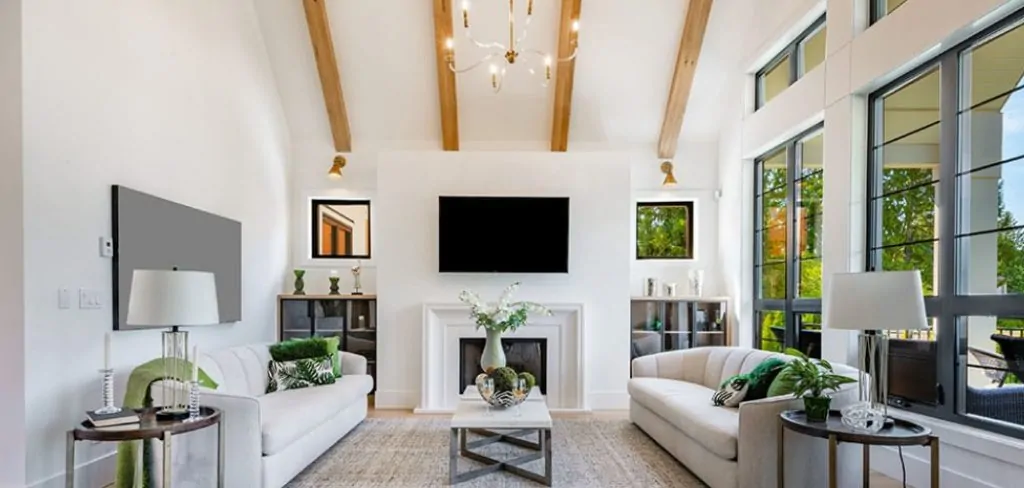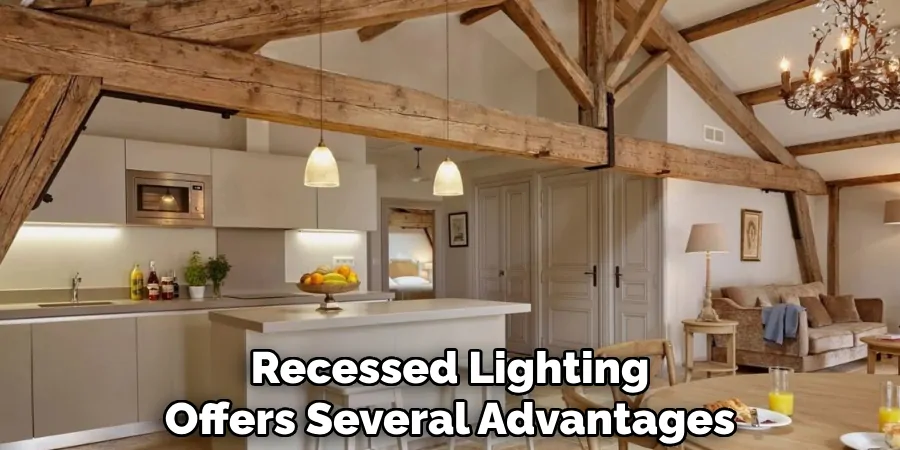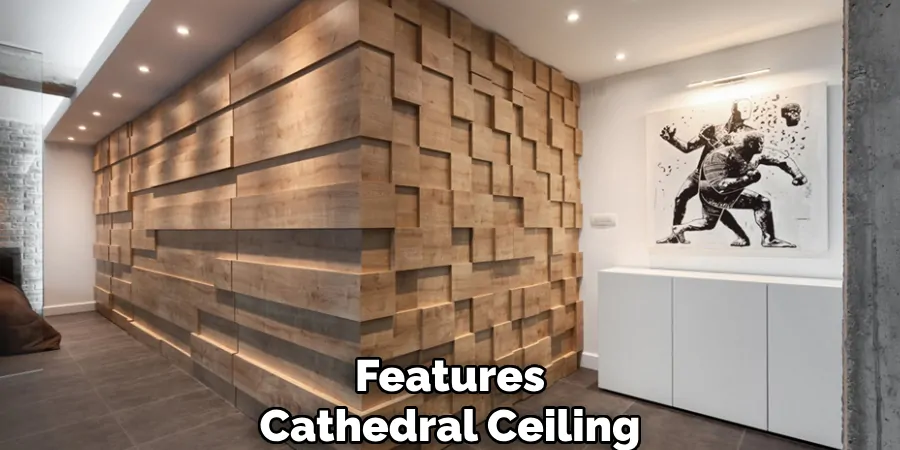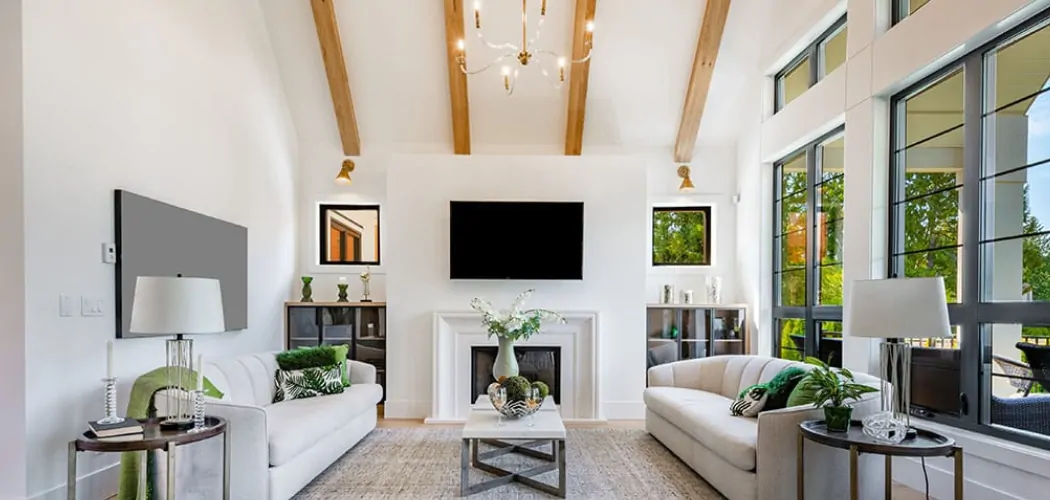Cathedral ceilings are a striking architectural feature that imbues a room with a sense of grandeur and openness. These high, sloped ceilings create a spacious feeling and add depth to interiors, often becoming the space’s focal point. However, the unique structure of cathedral ceilings can also present challenges in terms of lighting design.
Proper lighting is crucial in enhancing both the functionality and aesthetics of a room with a cathedral ceiling. By carefully planning the lighting layout, one can ensure that areas are sufficiently illuminated, creating a warm and welcoming environment while highlighting the room’s architectural details. This article serves as a comprehensive guide on how to light a cathedral ceiling, focusing on achieving a harmonious balance between ambiance and practicality through strategic fixture selection and placement.

Understanding the Lighting Needs of Cathedral Ceilings
Cathedral ceilings pose unique challenges when it comes to illumination. Their high, sloped structure can create vast, open spaces that often feel dim or have excessive shadows if not effectively lit. Addressing these challenges begins with recognizing the need for a balance between functional lighting, which provides necessary illumination for tasks, and ambient lighting, which sets the mood within the space.
In rooms with cathedral ceilings, it is crucial to highlight architectural features, such as beams and angles, while ensuring an even light distribution. This prevents areas from appearing too dark or overly lit, maintaining a harmonious atmosphere throughout. When planning lighting, considerations such as ceiling height, slope, and the presence of natural light play a vital role.
Additionally, opting for energy-efficient solutions is essential due to the often-inaccessible high placement of fixtures. Technologies like LED bulbs offer longevity and efficiency and aid in achieving the desired intensity and coverage, providing a practical approach to illuminating these grand spaces. By understanding and addressing these key factors, an effective lighting strategy can transform a room with a cathedral ceiling into a well-lit and inviting environment.
Types of Lighting for Cathedral Ceilings
Recessed Lighting (Can Lights)
Recessed lighting offers several advantages for cathedral ceilings. These discreet lights are built into the ceiling to provide a focused downward light, perfect for highlighting specific areas such as artwork or furniture. To maximize their effectiveness, consider using adjustable trims that allow you to direct the light as needed. This type of lighting creates a clean, modern look without cluttering the space with visible fixtures, making it ideal for maintaining the open feel of cathedral ceilings.

Pendant Lights and Chandeliers
Chandeliers can serve as a magnificent centerpiece in rooms with cathedral ceilings. These large, statement fixtures draw the eye and add elegance, reflecting the grandeur of the space. Conversely, pendant lights are excellent for providing focused task lighting or creating ambiance in targeted areas, such as over dining tables or kitchen islands. When choosing a chandelier or pendant, it’s important to scale the size appropriately to the room and ceiling height to maintain balance and proportion.
Track Lighting
Track lighting is highly versatile. It allows you to adjust the direction of each light to illuminate various rooms and accentuate different elements. By strategically placing track lighting along the slope of the ceiling, you can achieve both general and accent lighting, ensuring no corner is left in shadow. This flexibility makes track lighting an excellent choice for spaces that require adaptability in lighting options.
Wall Sconces and Uplighting
Uplighting along walls enhances the height and dramatic features of a cathedral ceiling. Wall sconces complement overhead lights as secondary sources, helping to reduce shadows and providing a more layered, comprehensive lighting scheme. This combination highlights architectural details and softens the room’s atmosphere.

Skylights and Natural Lighting
Skylights can dramatically improve the natural light within a room, filling it with sunlight throughout the day. They can effectively blend with electric lighting to balance natural and artificial sources, offering an energy-efficient lighting solution while enhancing the openness and brightness of a space with a cathedral ceiling.
How to Light a Cathedral Ceiling: Layering Light for Ambiance and Functionality
Ambient Lighting
Ambient lighting serves as a room’s primary illumination source, setting the overall mood and ensuring that the space feels inviting and well-lit. In rooms with cathedral ceilings, ambient lighting can be achieved by strategically using recessed lights, pendants, or chandeliers. Placing these fixtures at the appropriate height and distance allows for balanced dispersion of light, creating an even and warm glow throughout the room. Recessed lights can be spaced evenly across the ceiling to provide consistent coverage, while larger chandeliers or pendants can add a decorative element that complements the room’s grandeur.

Task Lighting
Task lighting is essential for performing specific activities such as reading, cooking, or working. In spaces with cathedral ceilings, it is important to focus light directly where it’s needed. Consider positioning pendants over kitchen islands to provide focused illumination for meal preparation or installing floor lamps near seating areas for comfortable reading environments. Centralizing task lights in high-use areas enhances functionality without compromising ambiance.
Accent Lighting
Accent lighting emphasizes particular features within a room, such as architectural details, artwork, or other focal points. In rooms with cathedral ceilings, uplights or wall-mounted fixtures can be placed strategically to highlight the slope of the ceiling or expose elegant beams. Accent lights draw attention to the room’s unique attributes, enhancing its aesthetic appeal while providing a layered lighting scheme that breathes life into the space.
Planning the Lighting Layout
Assessing the Room
Before developing a lighting plan, it’s crucial to evaluate the room’s function and furniture layout. Understanding how the space will be used—whether for relaxing, entertaining or dining—will guide the selection and placement of lighting fixtures. The furniture arrangement also plays a pivotal role; lighting should harmonize with the room’s setup to ensure practicality and aesthetic balance.

Measuring Ceiling Height and Slope
A precise measurement of the ceiling height and slope is essential when planning lighting for a room with a cathedral ceiling. Tools like laser distance meters or measuring tapes can scale the heights accurately. These measurements inform suitable fixture choices and their placement, as the ceiling’s pitch affects light dispersion. A steep slope may require lights that cast broader beams to ensure even illumination, while lower pitches might allow for more targeted lighting.
Positioning Fixtures
Strategically placing different lighting types ensures comprehensive coverage. For instance, recessed lights should be spaced evenly along the ceiling’s slope to create an uninterrupted light distribution. A chandelier or pendant is ideally centered above a focal point, such as a dining table, to draw the eye and anchor the space. Track lighting, when installed along the highest parts of the ceiling, offers flexibility, allowing for adjustable lighting to meet shifting needs.
Using Dimmers and Smart Controls
Dimmer switches are vital for adjusting lighting intensity, making it easy to transition from bright to subdued lighting depending on various activities or the time of day. Additionally, smart lighting systems enhance control, enabling homeowners to manage lights individually or in groups through smartphones or voice-activated devices. This seamless interaction raises the convenience and functionality of lighting layouts tuned to a home’s unique rhythm.

Choosing the Right Bulbs
LED Bulbs
LED bulbs are an excellent choice for cathedral ceiling lighting due to their energy efficiency, longevity, and versatility. They consume significantly less power than traditional incandescent bulbs, making them cost-effective and environmentally friendly. LEDs also have a long lifespan, significantly reducing the hassle of frequent replacements, which is particularly advantageous for lights installed in hard-to-reach high ceilings. Furthermore, LEDs are available in various brightness levels, allowing for customized lighting to meet specific needs.
Color Temperature and Brightness
The bulb’s color temperature, ranging from warm to cool, can noticeably influence the room’s ambiance. Warm light (around 2700K-3000K) creates a cozy, inviting atmosphere, ideal for relaxation areas, while neutral white (around 3500K-4100K) provides a balanced and clean light suitable for kitchens and workspaces. Cool white (5000K-6500K) is often used in tasks or work areas for its bright, energizing effect. Choosing the appropriate brightness, measured in lumens, is pivotal for ensuring adequate illumination based on room size and intended use.
Beam Angles for High Ceilings
For effective lighting in rooms with cathedral ceilings, selecting bulbs with wider beam angles is crucial. These bulbs ensure that light spreads efficiently across the room, avoiding shadows and dark spots. A recommended beam angle would be at least 60 degrees for high ceilings, providing broad coverage and even light distribution throughout the space.
Installing and Adjusting Fixtures
Hiring a Professional vs. DIY
When it comes to installing lighting fixtures in a room with cathedral ceilings, consider hiring a professional electrician, particularly for complex tasks like installing recessed lights or handling intricate wiring. The height and complexity involved can present significant challenges that are best managed by a skilled professional to ensure safety and proper functionality.
For those contemplating a DIY approach, having the right equipment is crucial. Ladders or scaffolding provide safe access to high ceilings, but confidence in basic electrical skills is essential. Be sure to follow all safety protocols and local regulations if you’re undertaking installation without professional assistance.
Adjusting Fixture Height and Placement
In large rooms with cathedral ceilings, hanging chandeliers or lower pendants help prevent them from feeling too distant, enhancing their visual impact and functional performance. A general guideline is to hang fixtures so they sit about 7 to 9 feet above the floor for optimal lighting without overwhelming the space. Achieving a balance between visual appeal and practicality involves careful consideration of ease of access for maintenance and bulb replacement, facilitating long-term usability.
Wiring for Slope
The unique slopes of cathedral ceilings can pose challenges in running electrical wiring, particularly for recessed lights or track lighting. Ensuring the wiring follows the ceiling’s contours is essential for both aesthetics and safety. Using conduit pipes can help manage wires neatly along the slope. Always adhere to safety tips when working with high-voltage wiring: power should be turned off at the breaker for your safety, and use appropriate tools like insulated pliers. If you are ever unsure about the safety aspects, consulting or hiring a professional is the best course of action.
Conclusion
Effective lighting for a room with a cathedral ceiling requires thoughtful planning and a strategic approach. Throughout this guide, we’ve highlighted the importance of accurately assessing your ceiling’s height and slope to choose and position fixtures appropriately. Emphasizing layering and integrating ambient, task, and accent lighting ensures both aesthetic appeal and functional brilliance. You can tailor the room’s ambiance to your needs with the right combination of LED bulbs, mindful of color temperature and brightness.
Whether it’s adjusting fixture heights or selecting bulbs with suitable beam angles, each step contributes to a harmonious lighting design. Remember, understanding how to light a cathedral ceiling is key to creating a welcoming and versatile environment. Using dimmers and smart controls gives you flexibility and convenience, ultimately enhancing the home’s atmosphere. Embrace the opportunity to mix different lighting types to achieve a balanced and well-lit space that complements your lifestyle.

